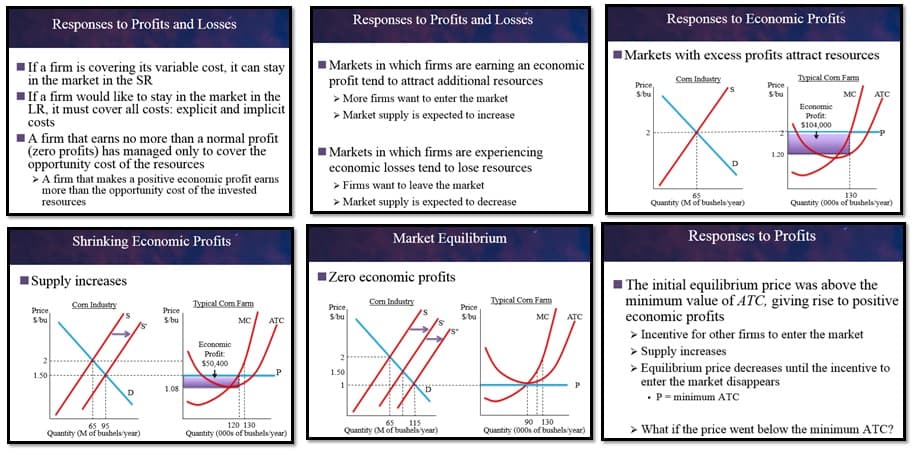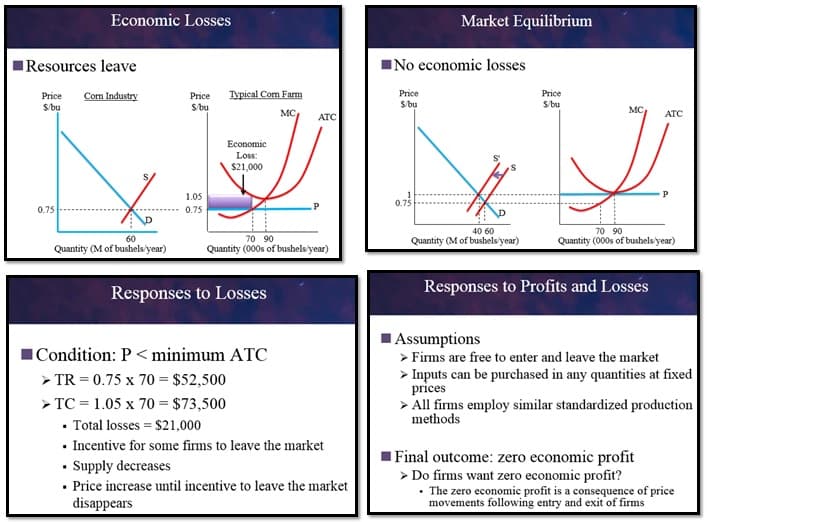Demonstrate how the allocation of resources across industries affects economic profit and economic loss. (please explain in details with graphs) Attached are the slides of the lecture.
Demonstrate how the allocation of resources across industries affects economic profit and economic loss. (please explain in details with graphs) Attached are the slides of the lecture.
Chapter1: Making Economics Decisions
Section: Chapter Questions
Problem 1QTC
Related questions
Question
Demonstrate how the allocation of resources across industries affects economic
Attached are the slides of the lecture.

Transcribed Image Text:Responses to Profits and Losses
Responses to Profits and Losses
Responses to Economic Profits
Markets with excess profits attract resources
If a firm is covering its variable cost, it can stay
in the market in the SR
If a firm would like to stay in the market in the
LR, it must cover all costs: explicit and implicit
Markets in which firms are earning an economic
profit tend to attract additional resources
> More firms want to enter the market
> Market supply is expected to increase
Com Indasty
Typical Com Farm
Price,
Sbu
Price
Sbu
MC
ATC
Economic
Profit:
S104,000
costs
A firm that earns no more than a normal profit
(zero profits) has managed only to cover the
opportunity cost of the resources
> A firm that makes a positive economic profit earns
more than the opportunity cost of the invested
Markets in which firms are experiencing
economic losses tend to lose resources
1.20
D
> Firms want to leave the market
> Market supply is expected to decrease
130
Quantity (000s of bushels'year)
65
resources
Quantity (M of bushels year)
Shrinking Economic Profits
Market Equilibrium
Responses to Profits
Supply increases
IZero economic profits
I The initial equilibrium price was above the
minimum value of ATC, giving rise to positive
economic profits
> Incentive for other firms to enter the market
> Supply increases
> Equilibrium price decreases until the incentive to
enter the market disappears
Com Industry
Typical Com Farm
Com Industry
Ispical Com Farm
Price
Price
Sbu
Price
Price
Sbu
Sbu
MC
ATC
Sbu
MC
ATC
Economic
Profit
$50,400
1.50
1.50
1.08
D
•P= minimum ATC
65
115
Quantity (M of bushels year)
90 130
Quantity (000s of bushels year)
> What if the price went below the minimum ATC?
120 130
65 95
Quantity (M of bushels'year)
Quantity (000s of bushels 'year)

Transcribed Image Text:Economic Losses
Market Equilibrium
Resources leave
INo economic losses
Com Industry
Typical Com Farm
Price
Price
Price
Рrice
Sbu
Sbu
Sbu
S'bu
MC
MC
ATC
ATC
Economic
Loss:
$21,000
1.05
0.75
0.75
0.75
70 90
Quantity (000s of bushels'year)
40 60
60
70 90
Quantity (M of bushels'year)
Quantity (M of bushels'year)
Quantity (000s of bushels'year)
Responses to Losses
Responses to Profits and Losses
IAssumptions
> Firms are free to enter and leave the market
> Inputs can be purchased in any quantities at fixed
prices
> All firms employ similar standardized production
methods
ICondition: P<minimum ATC
> TR = 0.75 x 70 = $52,500
> TC = 1.05 x 70 = $73,500
• Total losses = $21,000
• Incentive for some firms to leave the market
• Supply decreases
• Price increase until incentive to leave the market
disappears
Final outcome: zero economic profit
> Do firms want zero economic profit?
• The zero economic profit is a consequence of price
movements following entry and exit of firms
Expert Solution
This question has been solved!
Explore an expertly crafted, step-by-step solution for a thorough understanding of key concepts.
Step by step
Solved in 2 steps with 2 images

Knowledge Booster
Learn more about
Need a deep-dive on the concept behind this application? Look no further. Learn more about this topic, economics and related others by exploring similar questions and additional content below.Recommended textbooks for you


Principles of Economics (12th Edition)
Economics
ISBN:
9780134078779
Author:
Karl E. Case, Ray C. Fair, Sharon E. Oster
Publisher:
PEARSON

Engineering Economy (17th Edition)
Economics
ISBN:
9780134870069
Author:
William G. Sullivan, Elin M. Wicks, C. Patrick Koelling
Publisher:
PEARSON


Principles of Economics (12th Edition)
Economics
ISBN:
9780134078779
Author:
Karl E. Case, Ray C. Fair, Sharon E. Oster
Publisher:
PEARSON

Engineering Economy (17th Edition)
Economics
ISBN:
9780134870069
Author:
William G. Sullivan, Elin M. Wicks, C. Patrick Koelling
Publisher:
PEARSON

Principles of Economics (MindTap Course List)
Economics
ISBN:
9781305585126
Author:
N. Gregory Mankiw
Publisher:
Cengage Learning

Managerial Economics: A Problem Solving Approach
Economics
ISBN:
9781337106665
Author:
Luke M. Froeb, Brian T. McCann, Michael R. Ward, Mike Shor
Publisher:
Cengage Learning

Managerial Economics & Business Strategy (Mcgraw-…
Economics
ISBN:
9781259290619
Author:
Michael Baye, Jeff Prince
Publisher:
McGraw-Hill Education